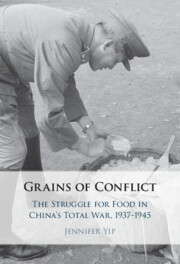
-
Select format
-
- Publisher:
- Cambridge University Press
- Publication date:
- August 2025
- July 2025
- ISBN:
- 9781009601344
- 9781009601320
- Dimensions:
- (229 x 152 mm)
- Weight & Pages:
- 0.583kg, 290 Pages
- Dimensions:
- Weight & Pages:
- Subjects:
- East Asian History, Area Studies, Asian Studies, Military History, History
You may already have access via personal or institutional login- Subjects:
- East Asian History, Area Studies, Asian Studies, Military History, History
Book description
China's war against Japan was, at its heart, a struggle for food. As the Nationalists, Chinese Communist Party, and Japanese vied for a dwindling pool of sustenance, grain emerged as the lynchpin of their strategies for a long-term war effort. In the first in-depth examination of how the Nationalists fed their armies, Jennifer Yip demonstrates how the Chinese government relied on mass civilian mobilization to carry out all stages of provisioning, from procurement to transportation and storage. The intensive use of civilian labor and assets–a distinctly preindustrial resource base– shaped China's own conception of its total war effort, and distinguished China's experience as unique among World War Two combatants. Yip challenges the predominant image of World War II as one of technological prowess, and the tendency to conflate total war with industrialized warfare. Ultimately, China sustained total war against the odds with premodern means: by ruthlessly extracting civilian resources.
Reviews
‘One of the most important issues for China during its titanic war against Japan was food supply. Jennifer Yip’s superb book is the definitive account of how vital grains were provided to keep the Nationalist armies fighting. Deep research and revisionist arguments come together to make this a powerful and essential book for all students of China’s World War II.’
Rana Mitter - Harvard Kennedy School
‘Grains of Conflict addresses an underappreciated yet fundamental aspect of the Sino-Japanese War. Jennifer Yip’s insightful analysis of the Nationalist Chinese efforts to extract grain from the countryside to feed its soldiers reveals a critical aspect of the war that underpinned the Chinese victory.’
Peter Worthing - Texas Christian University
Contents
Metrics
Full text views
Full text views help Loading metrics...
Loading metrics...
* Views captured on Cambridge Core between #date#. This data will be updated every 24 hours.
Usage data cannot currently be displayed.
Accessibility standard: WCAG 2.0 A
Why this information is here
This section outlines the accessibility features of this content - including support for screen readers, full keyboard navigation and high-contrast display options. This may not be relevant for you.
Accessibility Information
The PDF of this book conforms to version 2.0 of the Web Content Accessibility Guidelines (WCAG), ensuring core accessibility principles are addressed and meets the basic (A) level of WCAG compliance, addressing essential accessibility barriers.
Content Navigation
Table of contents navigation
Allows you to navigate directly to chapters, sections, or non‐text items through a linked table of contents, reducing the need for extensive scrolling.
Index navigation
Provides an interactive index, letting you go straight to where a term or subject appears in the text without manual searching.
Reading Order and Textual Equivalents
Single logical reading order
You will encounter all content (including footnotes, captions, etc.) in a clear, sequential flow, making it easier to follow with assistive tools like screen readers.
Visual Accessibility
Use of colour is not sole means of conveying information
You will still understand key ideas or prompts without relying solely on colour, which is especially helpful if you have colour vision deficiencies.
Use of high contrast between text and background colour
You benefit from high‐contrast text, which improves legibility if you have low vision or if you are reading in less‐than‐ideal lighting conditions.

